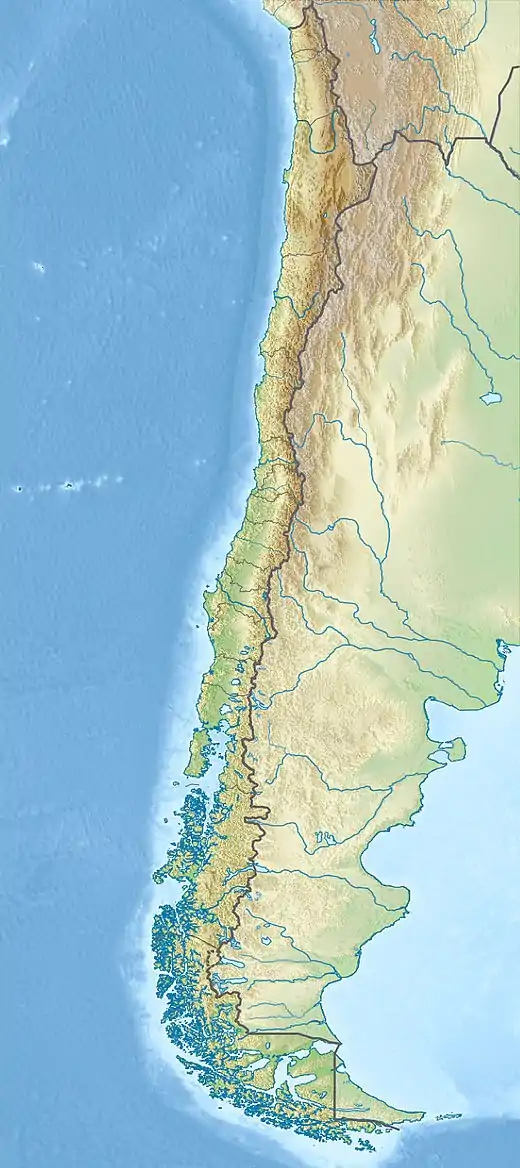Santa Juana Formation
Santa Juana Formation a Late Triassic (Carnian stage) sedimentary rock formation near Santa Juana in the lower course of the Biobío River in south-central Chile.[1] Lithologies range from conglomerate sandstone, arkosic sandstone, siltstone and mudstone.[2]
| Santa Juana Formation Stratigraphic range: Carnian ~235–222 Ma | |
|---|---|
| Type | Geological formation |
| Sub-units | Talcamávida-Gomero, Unihue & Quilacoya Members |
| Overlies | Coastal Batholith of central Chile |
| Thickness | Unknown |
| Lithology | |
| Primary | Conglomerate, sandstone, siltstone |
| Other | Arkosic sandstone, mudstone, volcanic rock, anthracite |
| Location | |
| Coordinates | 37.2°S 73.0°W |
| Approximate paleocoordinates | 53.8°S 39.9°W |
| Region | Bío Bío Region |
| Country | |
| Type section | |
| Named for | Santa Juana |
| Named by | Ferraris |
| Year defined | 1981 |
 Santa Juana Formation (Chile) | |
Description
The sediments that consolidate into the rocks of the formation deposited in alluvial, fluvial, lacustrine and playa lake environment. Overall, the formation is rich in plant fossils.[2]
The formation was deposited over the rocks of the Coastal Batholith of central Chile in a sedimentary basin that formed along the Gastre Fault. It has been posited that the basin developed as a rift during the early break-up of Gondwana in the Triassic.[2]
Fossil content
The following fossils have been reported from the formation:[1]
Flora
- Asterotheca fuchsii[2]
- A. rigbyana[3]
- Baiera africana[3]
- B. furcata[3]
- Cladophlebis mendozaensis[3]
- Dicroidium coriaceum[3]
- D. crassinervis[2]
- D. elongatum[2]
- D. odontopteroides[2][3]
- Dictyophyllum fuenzalidai[2]
- D. tenuifolium[2][3]
- Gleichenites quilacoyensis[3]
- Gontriglossa reinerae[2]
- Heidiphyllum elongatum[2][3]
- Kurtziana cacheutensis[2]
- Linguifolium lilleanum[3]
- L. steinmannii[2]
- Pterophyllum santajuanensis[2][3]
- Rissikia media[2]
- Saportaea dichotoma[2]
- Sphenobaiera africana[2]
- Sphenopteris cf. polymorpha[3]
- Taeniopteris sp.[3]
- Taeniopteris vittata[3]
- Telemachus elongatus[2]
- Thaumatopteris rothii[2]
- Todites chilensis[3]
- cf. Pseudoctenis fissa[2]
- Cladophlebis sp.[2][3]
- Dicroidium sp.[2]
- Gleichenites sp.[2]
- ?Antevsia sp.[2]
Branchiopoda
- Polygrapta troncosoi[4]
- Menucoestheria terneraensis[4]
See also
- Chañares Formation, fossiliferous formation of the Ischigualasto-Villa Unión Basin, Argentina
- Candelária Formation, contemporaneous fossiliferous formation of the Paraná Basin, Brazil
- Molteno Formation, contemporaneous fossiliferous formation of Lesotho and South Africa
- Pebbly Arkose Formation, contemporaneous fossiliferous formation of Botswana, Zambia and Zimbabwe
- Denmark Hill Insect Bed, contemporaneous fossiliferous unit of Queensland, Australia
- Madygen Formation, contemporaneous Lagerstätte of Kyrgyzstan
References
- Santa Juana Formation at Fossilworks.org
- Nielsen, 2005
- Moisan et al., 2010
- Martins Neto et al., 2003
Bibliogahy
- Moisan, P.; E. Abad; B. Bomfleur, and H. Kerp. 2010. A Late Triassic flora from Gomero (Santa Juana Formation), Chile. Neues Jahrbuch für Geologie und Paläontologie - Abhandlungen 258. 89-106.
- Nielsen, Sven N. 2005. The Triassic Santa Juana Formation at the lower Biobío River, south central Chile. Journal of South American Earth Sciences 19. 547–562. doi:10.1016/j.jsames.2005.06.002
- Martins Neto, R. G.; O. F. Gallego, and R. N. Melchor. 2003. The Triassic insect fauna from South America (Argentina, Brazil and Chile): a checklist (except Blattoptera and Coleoptera) and descriptions of new taxa. Acta Zoologica Cracoviensia 46 (Suppl). 229-256.